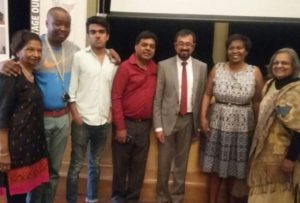 This year the Gandhi Media Lecture was delivered by Prof Aashish Kumar of Hofstra University, New York. He spoke on self reliance in the context of social media. In building a case for participatory social media he illustrated three case studies, from Canada, India and South Africa.
This year the Gandhi Media Lecture was delivered by Prof Aashish Kumar of Hofstra University, New York. He spoke on self reliance in the context of social media. In building a case for participatory social media he illustrated three case studies, from Canada, India and South Africa.
He referred to the present era and its reluctance to accept and appreciate Gandhian ideals but suggested that his presentation was impacted by Gandhian writings and activism
He brilliantly described the Gandhian modality of work when he said, “..for Gandhi, there was no separation between seeking social change and the quest for human dignity and equality; between protesting exploitation under a colonial power and condemning exploitative traits within the colonised; between self reliance and self governance. This internal- external consistency is the cornerstone of the Gandhian project of liberation.”
An important point made by Prof. Kumar was that Gandhi had illustrated to the world that it is possible for a people to free themselves even before the oppressor frees them through self reliance, through discarding fear, through being able to meet your needs yourself and above all through governing yourself.
Translating these views in the sphere of media he spoke of the importance of independent self expression and being able to “speak truth to power”
But the advent of radio and then television and the rapid commercialisation of the media has led to a situation where media produces what people want and hence the real stories are seldom heard.
But then community media provided an alternate avenue and documentaries began to be produced. A project undertaken by Colin Low on the Fogo Island illustrates the importance of community autonomy. The important issue here is he said, “At the core of this process was the belief that communities must have control or autonomy over how they represent themselves to each other and to the world.”
The Fogo process identified 10 principles:
-
Original ideas or goals come from community partners
-
Adapt documentary forms to the original idea.
-
Participate rather than just observe and record
-
Work closely with partner but respect each other’s independence and expertise.
-
Choose a suitable medium for communication
-
Ethics privacy and consent vital
-
The goals and the process are paramount. Ask yourself everyday- why are you doing this project
-
Always tell a good story
-
Track the process and disseminate what you have learned
-
Outreach matters- spend 10% of time making it and 90% in getting it out there.
He then went on to refer to video technology and how it impacted on the lives of the Self Employed Women’s Association (SEWA) an NGO in India where after a training session women were able to use the skills to promote their work. They rejected the view that “access to communication media is a luxury for the poor, and insisting that it is an information right instead.”
Then in the 90’s emerged the internet and he asserted, “The internet started supplanting the airwaves and satellite as the unifying or mediating strand in communities, fostering a sense of common concerns.” This was illustrated in a Candian project called highrise where people living in highrise buildings speak out about their own concerns and through this media get the ears of the city.
Similarly in Johannesburg through the Sisonke sex workers organisation they were able to place the views, fears and anxieties of the urban dwellers into the public domain through the use of social media. All this is possible when media works in close contact with communities. Prof Kumar said in conclusion “the road to participatory democracy is forged from relentless and iterative community processes”

